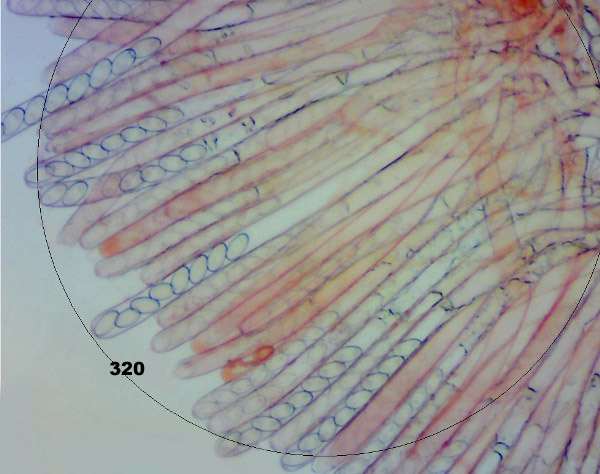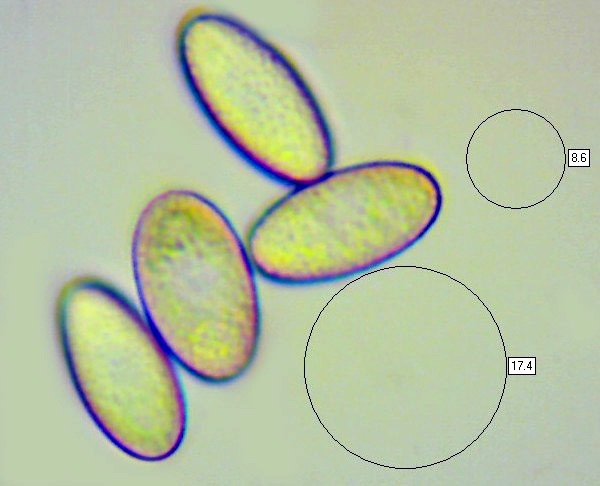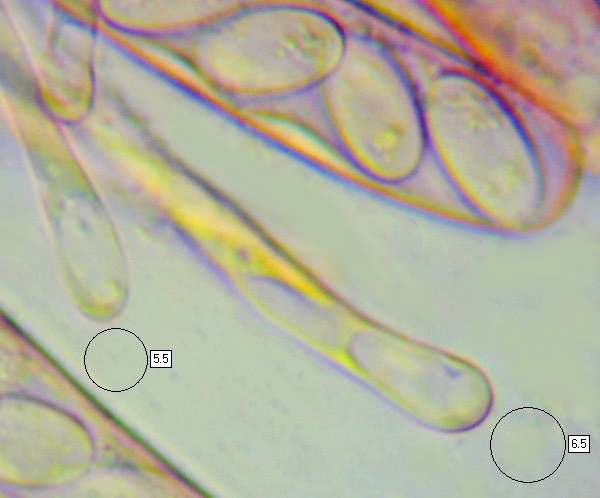Peziza arvernensis Roze & Boud.
Phylum: Ascomycota - Class: Pezizomycetes - Order: Pezizales - Family: Pezizaceae
Distribution - Taxonomic History - Etymology - Identification - Culinary Notes - Reference Sources
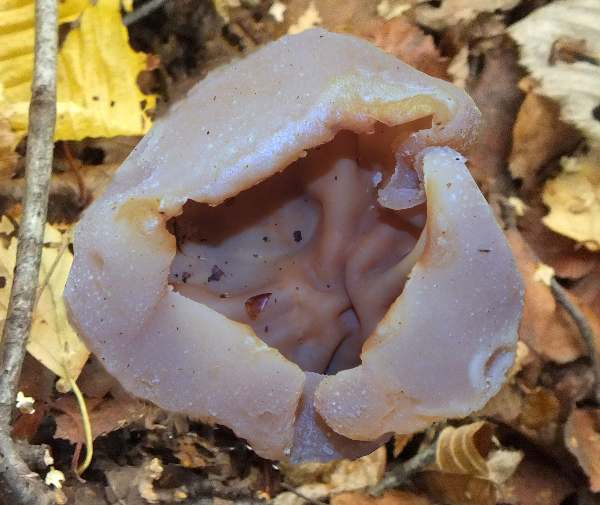
Cup fungi, and brownish ones in particular, are particularly difficult to identify with certainty, and Peziza arvernensis is no exception; however, by using a good key with microscopoic characters such as spore size, shape and ornamentation it is readily separable from other macroscopically similar species.
The fertile surface is inside the cup, as with all Peziza species. As gusts of wind blow across the top of the cup, the resulting change in air pressure triggers the discharge of ripe spores from within their asci flasks; the spores are then carried away on the breeze - a cunning system for releasing spores at times that are best for their long-range distribution!
Distribution
Peziza arvernensis is an uncommon find in Britain, where it occurs on soil in broadleaf and mixed woodlands. This cup fungus occurs also in many parts of mainland Europe and in North America.

Taxonomic history
This cup fungus was described scientifically in 1879 by French mycologists Ernest Roze (1833 - 1900) and Jean Louis Emile Boudier, who called it Peziza arvernensis - the name by which it is still generally known today.
Synonyms of Peziza arvernensis include Aleuria arvernensis (Roze & Boud.) Gillet, Peziza silvestris (Boud.) Sacc. & Traverso, and Galactinia sylvestris (Boud.) Svrček.
Etymology
Peziza, the genus name, may come from a Latin root referring to a foot - most fungi in this group being sessile (footless or stemless). The specific epithet arvernensis refers to the Auvergne region of central-southern France.
Identification guide
 |
Fertile surfaceStemless cup fungus, initially hemispherical, opening to form a cup, often with an inrolled wavy margin, usually splitting at maturity; 3 to 7cm (exceptionally to 10cm) across. The inner surface is often slightly wrinkled, most noticeably in the central region. The rather fragile flesh is pinkish and 0.5 - 2mm thick. Yellowish brown to pinkish brown, the hymenium (the fertile upper surface) turns mid brown with age and exposure to daylight; its surface is smooth and waxy. |
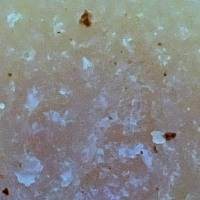 |
Infertile surfaceThe infertile lower surface is pale buff near the margin becoming progressively more brown tinted towards the base. The surface texture is granular/fufuraceous.
|
 |
AsciCylindrical, amyloid, typically 300 x 15µm; uni-seriate with eight spores per ascus. |
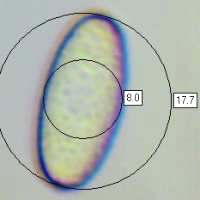 |
SporesEllipsoidal, very finely verrucose, 17-19 x 8-10.5µm, Q=1.7-2.0; hyaline; without guttules. Spore printWhite. |
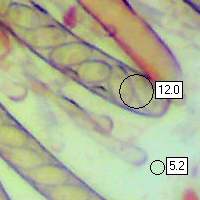 |
ParaphysesSmooth, cylindrical, typically 4µm in diameter with slightly capitate tips typically 5-7µm across. |
Odour/taste |
Not distinctive. |
Habitat & Ecological role |
Peziza arvernensis is a saprophyte and occurs on damp soil in broadleaf and mixed woodlands, most commonly with Beech trees (Fagus spp.); also occasionally on sawdust and woodchip. |
Season |
Mainly March to November in Britain and Ireland. |
Similar species |
There are at least 100 Peziza species and definite identification is rarely possible without microscopic examination. |
Culinary Notes
This cup fungus is not considered edible. It is most probably poisonous if eaten raw or inadequately cooked, when it could at least cause seriously unpleasant stomach upsets. (The same is true even of noted edible ascomycetes such as Morchella esculenta, the Morel, and Morchella elata, the Black Morel.)
Reference Sources
Fascinated by Fungi, 2nd Edition, Pat O'Reilly 2016, reprinted by Coch-y-bonddu Books in 2022.
Dennis, R.W.G. (1981). British Ascomycetes; Lubrecht & Cramer; ISBN: 3768205525.
Breitenbach, J. & Kränzlin, F. (1984). Fungi of Switzerland. Volume 1: Ascomycetes. Verlag Mykologia: Luzern, Switzerland.
Medardi, G. (2006). Ascomiceti d'Italia. Centro Studi Micologici: Trento.
Donadini J.C. 1981. Le genre Peziza dans le sud-est de la France, avec clef du genre pour la France; Universite d'Aix-Marseille
BMS List of English Names for Fungi
Dictionary of the Fungi; Paul M. Kirk, Paul F. Cannon, David W. Minter and J. A. Stalpers; CABI, 2008
Taxonomic history and synonym information on these pages is drawn from many sources but in particular from the British Mycological Society's GB Checklist of Fungi.
Fascinated by Fungi. Back by popular demand, Pat O'Reilly's best-selling 450-page hardback book is available now. The latest second edition was republished with a sparkling new cover design in September 2022 by Coch-y-Bonddu Books. Full details and copies are available from the publisher's online bookshop...
